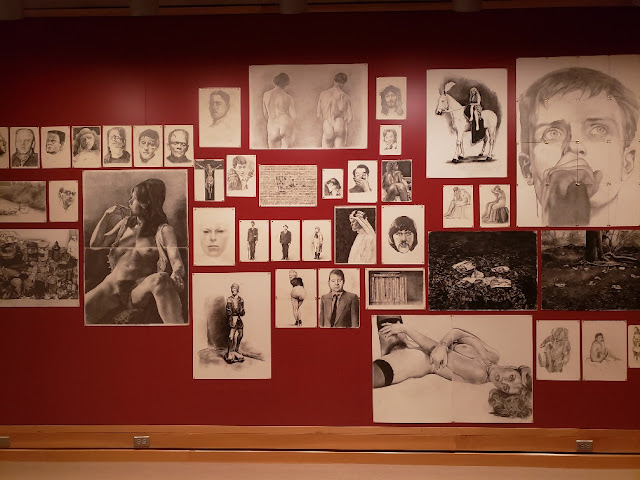The Art of George Shaw
Paper 2 Yale Center for British Art
Yale Center for British Art
A George Shaw retrospective exhibition is currently being displayed
at the Yale Center for British Art. Prior to stumbling upon the third-floor
exhibition, I had never heard his name, discounting of course playwright George
Bernard Shaw. Initially I was not overly impressed, thinking the first couple
were no more than colorful and unimaginative photographs, there goes my ill-advised
prejudgments again. However, after getting closer and reading the placards, I
became instantly enthralled. Shaw studied art at Sheffield Polytechnic, which is a public university in Sheffield, South Yorkshire. He then received his MA in painting from the Royal College of Art in London in 1998.
Shaw is thought of as one of Britain's leading contemporary painter's. The collection at the Yale Center contains also seventy paintings, more than sixty drawings, and many of his sketchbooks and notebooks.
From the Yale Center for British Art's website:
Steeped in modern and historic traditions, Shaw's work alludes equally to twentieth-century painting and photography, as well as historic masters of European painting such as Titian (1490-1576), whose paintings of Diana and Acteon directly influenced his Sporting Life (2009), which testify to his ability to capture the
melancholy and poignant aspects of modern British culture.
This is Shaw's first solo exhibition in the United States.
The first two were among those that I almost wrote off on
face value. But once a closer examination is taken, one notices the rain-soaked
ground and its reflective shine. Then I
read the placard to learn that he painted on a board using Humbrol.
One of the security guards approached and told of the recent
visit by Shaw to the gallery to discuss his art. The guard admits to being a
newly minted admirer of Shaw. I asked him what was Humbrol, saving myself a
google search, and told it was the type of paint used on models, not the
fashion kind because that might be weird, but the plastic scale models. When
considering the media he utilized, new appreciation is given to the level of
skill he brings to his art. The security guard I must say should be hired to promote
Shaw’s work, rarely have I seen such enthusiasm.
Shaw painted the familiar, most, if not all, of his
paintings where made in homage to his hometown of Coventry in England where he
lived until he was eighteen. The following are the paintings are from his
series, The Passion.
Scenes from the Passion: The Telephone Box
Scenes from the Passion: Late
Scenes from the Passion: The Black Prince
Scenes from the Passion: A Few Days before Christmas 2002-3
Scenes from the Passion: The Path to Pepys Corner 2001
Scenes from the Passion: The Hawthorne Tree 2001
Shaw made a sizable amount of charcoal drawing on paper.
Shaw made a sizable amount of charcoal drawing on paper.
His Frankenstein’s monster drawing copied from the iconic movie poster.
Below are from his Woodsman drawings made in the woods where he walked with his father as a child. Made after his father's death they were part therapeutic, part tribute. But of course, that statement is conjecture on my part.
I have no idea why I did such a poor job framing these photos,
fortunately this isn’t a photography class.
Here are a few more of Shaw’s painting that I am still in
awe of the use of Humbol and the glossy effect it produces but the level of
skill he has makes the paintings look like photographs.
Again, forgive the horrible photo framing.
References
https://en.wikipedia.org/wiki/George_Shaw_(artist)





















Your pictures are quite good, actually. I don't find them to be horrible. I'm glad you got to talk to the guard and find out more about the medium he used.
ReplyDeletePerhaps you could expand the written portion of your work to include a reflection about Shaw's intent as an artist. Does his work convey the emotion about modern England versus postwar idealism? How does it do this?
Interesting to see someone else notice the photorealism of his work. I also enjoyed his slick, reflective surfaces in his pieces.
ReplyDeleteI didn't stop to look at the sketches of the woods he produced, so I'm seeing them for the first time right now. One of the things that goes through my mind as I travel to these exhibits is occasionallt I will stop and view a piece because features of the work will bring to mind another painting, drawing, album cover, book cover, etc. In this instance, the overall haze of the third and fourth drawings and the decayed look of the forest brings to mind the album cover to Cradle of Filth's 2001 album Dusk and Her Embrace; very haunting visual. I guess it is possible both drew inspiration from the same region of the UK; Coventry and Suffolk are not that far apart.
I like how the sketches remind you of other things. I feel the same way in that they impart a sense of familiarity that I just can't place, but am mildly comforted by.
ReplyDelete